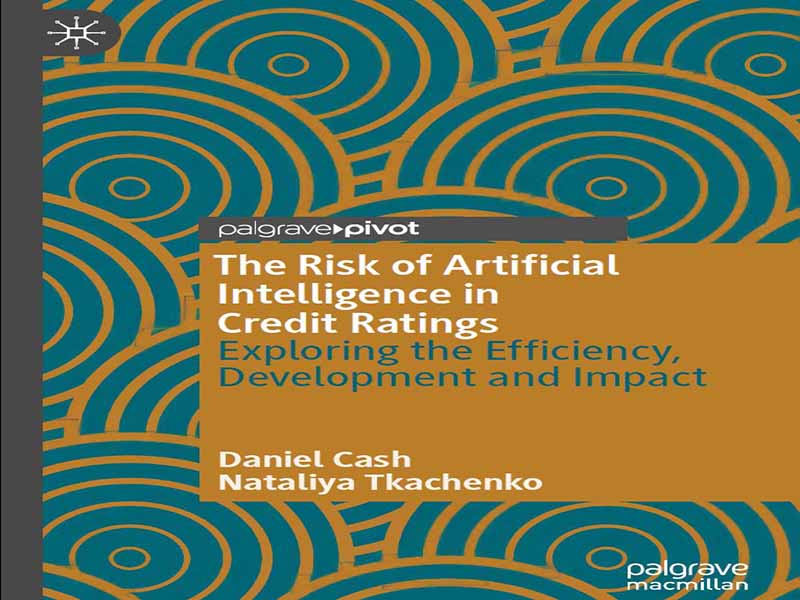- عنوان کتاب: The Risk of Artificial Intelligence in Credit Ratings
- نویسنده: Daniel Cash · Nataliya Tkachenko
- حوزه: مخاطرات هوش مصنوعی
- سال انتشار: 2025
- تعداد صفحه: 108
- زبان اصلی: انگلیسی
- نوع فایل: pdf
- حجم فایل: 0.92 مگابایت
این کتاب که در اوایل سال ۲۰۲۵ نوشته شده است، در مراحل بسیار اولیه سفری قرار دارد که میتواند تمدن بشری را تعریف کند. پذیرش فناوریهای هوش مصنوعی (AI) تقریباً در هر بخشی، نحوه عملکرد جهان، نحوه درک جهان از چیزهای ساده تا فوقالعاده پیچیده را تغییر میدهد و آنچه را که جهان برای آینده خود ممکن میداند، تغییر میدهد. اما، در بیشتر موارد، همه چیز خیلی زود است.
مرحله نوپای توسعه در هر زمینهای، خلاصه کردن، پیشنهاد دادن یا اعلام کردن را دشوار میکند. در مورد ارزیابی ریسک اعتباری، واقعاً خیلی زود است. این کار بر آژانسهای پیشرو رتبهبندی اعتباری و نحوه پذیرش فناوریهای هوش مصنوعی توسط آنها متمرکز است، اما چرا؟ نکته نگرانکننده در اینجا، ادغام چندین عامل است که به اعتقاد ما میتوانند عوامل مرتبطی باشند که تنظیمکنندگان و قانونگذاران باید در نظر بگیرند. کسانی که وظیفه ایجاد، حفظ و در نهایت تکامل چارچوبهای نظارتی که در اطراف آژانسهای پیشرو رتبهبندی اعتباری قرار دارند را بر عهده دارند، وظیفه قابل توجهی دارند. این وظیفه قابل توجه است زیرا آنها ناگزیر از قافله عقب هستند. چارچوب نظارتی بر بخشی متمرکز است که به طور هم افزایی به ثروت بدهی و اعتبار خصوصی وابسته است، که در دنیای مدرن تقریباً برای زندگی بشر اساسی است. همین واقعیت، با توجه به اهمیتش، به تنهایی بر همه طرفها تأثیر میگذارد. آژانسهای رتبهبندی اعتباری موقعیت سیستمی خود را درک میکنند. تنظیمکنندگان میدانند که محدودیتهایی برای اقداماتی که میتوانند در نتیجه انجام دهند وجود دارد. سرمایهگذاران اهمیت خود و ابزارهایی را که در اختیار دارند، مانند رتبهبندی آژانسها، درک میکنند. در نهایت، صادرکنندگان میدانند که برای نشان دادن اعتبار خود به یک پایگاه سرمایهگذار متنوع که توسط رابطه نماینده-مدیر تعریف میشود، به رتبهبندیهای شخص ثالث آسان برای درک و از نظر تئوری بیطرف آژانسهای رتبهبندی اعتباری نیاز دارند. سیستمی در درون یک سیستم. با این حال، این محدودیتها و عوامل الزامآور دارای مشکلاتی هستند. اگر آژانسهای رتبهبندی اعتباری، پس از درک آن پویایی، تصمیم بگیرند که در صورت تخلف، موقعیت خود را از دست ندهند، چه میشود؟ چه اتفاقی میافتد اگر، علیرغم نقش اذعانشده شما که ارائه خدمات به سرمایهگذاران است، صرف نظر از این واقعیت که صادرکنندگان هستند که برای رتبهبندیها هزینه پرداخت میکنند (فراموش نکنیم، دومین آژانس بزرگ رتبهبندی اعتباری تقریباً در تمام طول عمر خود از زمان تأسیس با نام سرویس سرمایهگذاران مودی شناخته میشد)، یک آژانس رتبهبندی اعتباری به این نتیجه برسد که میتواند روشهای خود را دستکاری کند و اطلاعات اساسی کلیدی را نادیده بگیرد تا به صادرکنندگان پول بدهد، آن هم به قیمت سرمایهگذارانی که میدانند آسیب خواهند دید؟ مجازات یا عامل بازدارنده بسیار کمی در سیستم حقوقی پیرامون آژانسهای رتبهبندی اعتباری وجود دارد. حال تصور کنید که همه این اتفاقات رخ دهد و یک چارچوب قانونی ایجاد شود که اکنون شامل مانعی برای مسئولیت باشد و متعاقباً، آن چارچوب قانونی عمل کند. این اقدام در نهایت منجر به بزرگترین توافقهای مالی ثبتشده برای صنعت رتبهبندی اعتباری، به مبلغ ۱.۳ میلیارد دلار و ۸۶۴ میلیون دلار برای دو آژانس بزرگ رتبهبندی اعتباری میشود، اما با کمی تأمل، این مجازاتها کسری از پولی است که از تخلف حاصل میشود. یک پاسخ سیستمی که یک سیگنال واضح ارسال میکند، اما شاید آن سیگنالی نباشد که سیستم فکر میکند ارسال میکند. موارد فوق، به طور خلاصه، مشارکت آژانسهای رتبهبندی اعتباری در بحران مالی جهانی است. داستان، از ابتدا تا انتها به سرعت روایت میشود. اما برای ما، اکنون (ظاهراً) در مرحله پس از بحران مالی جهانی هستیم. امروز، ما یک انحصار چندجانبه رتبهبندی اعتباری حتی بزرگتر، تأثیرگذارتر و غنیتر از منابع داریم که نه تنها از بزرگترین آزمایش خود جان سالم به در برده، بلکه علیرغم آن رشد کرده است. آزمایش واقعی برای آژانسهای رتبهبندی اعتباری نیست، بلکه برای چارچوب نظارتی است که در پاسخ به نقش آژانسهای رتبهبندی اعتباری در بحران مالی جهانی ایجاد شده است. آیا این چارچوب میتواند در برابر هر آنچه که در آینده رخ خواهد داد، مقاومت کند؟ هر آنچه که در آینده رخ دهد، اگر اصلاً رخ دهد، در محیطی مبتنی بر یک درک ساده اتفاق خواهد افتاد: همه طرفهای مربوطه، صرف نظر از اینکه بتوانند آن را بیان کنند یا نه، میدانند که این «سیستمی» که برای شما توصیف کردهایم باید حفظ شود. نمیتوان آن را نادیده گرفت یا حتی تغییر داد. این سیستم برای حرکت اعتبار در مقیاس جهانی، شامل شرکتها، کشورها، محصولات مالی و هر چیز دیگری در این بین، اساسی است. به همین دلیل است که از زمان بحران مالی جهانی، هر تلاشی برای تغییر سیستم شکست خورده است.
This book, written early in 2025, exists at the very early stages of a journey that could define human civilisation. The adoption of artificial intelligence (AI) technologies across almost every sector is changing the way in which the world operates, how the world understands something ranging from the simple to the incredibly complex, and it is changing what the world believes is possible for its future. But, for the most part, it is all very early.
The nascent stage of development in any field makes it difficult to summarise, suggest or declare. With respect to credit risk assessment, it is very early indeed. This work is focused on the leading credit rating agen-cies and how they are adopting the AI technologies, but why? Of concern here is the amalgamation of several factors which we believe could be pertinent factors for regulators and legislators to consider. Those tasked with creating, maintaining and ultimately evolving the regulatory frame-works that sit around the leading credit rating agencies have a remarkable task. It is remarkable because they are inevitably behind the curve. The regulatory framework is focused on a sector that is synergistically attached to the fortunes of private debt and credit, which in the modern world is almost fundamental to human life. That fact alone, given its weight, affects all parties. Credit rating agencies understand their systemic posi-tion. Regulators understand that there are limits to actions they can take as a result. Investors understand their importance and the tools at their disposal, like the ratings of the agencies. Finally, issuers understand that, to signal their creditworthiness to a diversified investor base that is defined by the agent-principal relationship, they need the easy-to-understand and theoretically impartial third-party ratings of the credit rating agencies. A system within a system.
However, those binding constraints and factors have pitfalls. What if the credit rating agencies, after understanding that dynamic, decide they cannot lose their position if they transgress? What happens if, despite your acknowledged role being to provide services to investors irrespective of the fact it is issuers who pay for ratings (let’s not forget, the second largest credit rating agencies was known as Moody’s Investors Service for nearly all of its life since its foundation), a credit rating agency makes a summation that they can manipulate their methodologies and overlook key underlying information in order to please paying issuers at the expense of investors who they know will be harmed? There is very little punish-ment or deterrent available within the legal system that surrounds the credit rating agencies. Now imagine that this all happens, and a legal framework is erected which now includes a bar for liability and, subse-quently, that legal framework acts. That action, eventually, results in the largest financial settlements ever recorded for the credit rating industry, at $1.3 billion and $864 million for the two largest credit rating agencies but, on reflection, those penalties are a fraction of the money made by transgressing. A systemic response that sends a clear signal, but perhaps not the one the system thinks it is sending.
The above, in a framed nutshell, is the credit rating agencies’ involve-ment in the Global Financial Crisis. The story, delivered in rapid fashion, from start to finish. But for us, we are now in a post-Global Financial Crisis stage (ostensibly). Today, we have an even bigger, more influential, more resource-rich credit rating oligopoly that has not only survived its biggest test but thrived in spite of it. The real test is not for the credit rating agencies, but instead for the regulatory framework that was erected in response to the credit rating agencies’ role in the Global Financial Crisis; can it withstand whatever comes next? Whatever comes next, if at all, will happen within an environment based upon a simple under-standing: all of the relevant parties know, irrespective of whether they can articulate it or not, that this ‘system’ we have described for you must be maintained. It cannot be disregarded, or even altered. It is central to the movement of credit on a global scale, encompassing companies, coun-tries, financial products and everything else in between. This is why every attempt to change the system since the Global Financial Crisis has failed.
این کتاب را میتوانید از لینک زیر بصورت رایگان دانلود کنید:
Download: The Risk of Artificial Intelligence in Credit Ratings



































نظرات کاربران